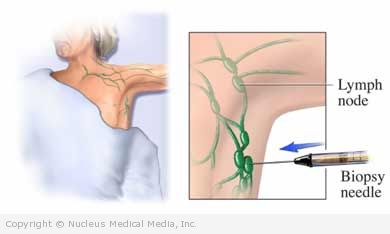Lymph node biopsy
(Biopsy Lymph Nodes)
Lymph node biopsy – Definition
Lymph nodes are found throughout the body. They are part of the body’s immune system. These nodes help fight infection by producing special white blood cells. They also work by trapping bacteria, viruses, and cancer cells. Normally, lymph nodes cannot be felt unless they are swollen. Infection, usually by a virus, is the most common cause of lymph node swelling. Other causes include inflammatory diseases, abscesses, and cancer.
With this type of biopsy, the doctor removes and examines all or part of a lymph node.
Lymph node biopsy – Reasons for Procedure
This biopsy is done to find out why a node is swollen. It can also be done to see if there are cancer cells in the lymph node.
Common areas for biopsy include:
- Groin
- Armpit
- Neck
- Under the jaw and chin
- Behind the ears
Lymph node biopsy – Possible Complications
Complications are rare, but no procedure is completely free of risk. If you are planning to have a lymph node biopsy, your doctor will review a list of possible complications, which may include:
- Bleeding
- Infection
- Nerve damage (including numbness at the biopsy site)
Lymph node biopsy – What to Expect
Prior to Procedure
Leading up to your procedure, you will need to:
- Talk to your doctor about your medical history, including:
- Any allergies that you have
- Any medicines you take (including over-the-counter drugs and herbs and supplements). You may be asked to stop taking some medicines up to one week before the procedure, like:
- Anti-inflammatory drugs (eg, aspirin)
- Blood thinners, such as clopidogrel (Plavix) or warfarin (Coumadin)
- Arrange for a ride home from the care center.
- The night before, do not eat or drink anything after midnight if you will have general anesthesia.
Lymph node biopsy – Anesthesia
- Local anesthesia — just the area that is being operated on is numbed; given as an injection and may also be given with a sedative
- General anesthesia (used for open biopsies) — blocks pain and keeps you asleep through the surgery; given through an IV in your hand or arm
Lymph node biopsy – Description of the Procedure
Lymph nodes samples can be obtained by:
- Needle biopsy
- Open biopsy
Needle Biopsy
There are two types of needle biopsies:
- Fine needle biopsy — The doctor will use a thin, hollow needle to obtain tissue samples.
- Core needle biopsy — The doctor will use a larger needle to cut out a piece of tissue.
The doctor may use an ultrasound or CT scan to help locate the biopsy site.
Open Biopsy
An open biopsy means removing the lymph nodes through an incision. The doctor will cut into the skin and remove either all or part of a lymph node. After removal, the incision will be closed with stitches and bandaged.
Lymph node biopsy – Immediately After Procedure
The sample will be sent to the lab for examination.
Lymph node biopsy – How Long Will It Take?
About 30-60 minutes (longer if an ultrasound or CT scan is used)
Lymph node biopsy – How Much Will It Hurt?
You will have some pain and tenderness after the biopsy is taken. Your doctor may give you pain medicine.
Lymph node biopsy – Post-procedure Care
When you return home after the procedure, do the following to help ensure a smooth recovery:
- Keep the biopsy site clean and dry.
- Ask your doctor about when it is safe to shower, bathe, or soak in water.
- Be sure to follow your doctor’s instructions.
Results will be ready in about a week. Your doctor will tell you if further treatment is needed.
Lymph node biopsy – Call Your Doctor
After arriving home, contact your doctor if any of the following occurs:
- Signs of infection, including fever and chills
- Redness, swelling, increasing pain, excessive bleeding, or any discharge from the incision site
- New or worsening symptoms
In case of an emergency, call for medical help right away.

